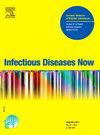Cutaneous infections with Corynebacterium diphtheriae in France: A cohort study
IF 2.2
4区 医学
Q2 INFECTIOUS DISEASES
引用次数: 0
Abstract
Introduction
Cutaneous diphtheria typically develops on preexisting skin lesions and presents as painful, well-defined ulcers covered by false membranes or as exudate, usually on the limbs.
Patients and methods
We report on six cases of cutaneous diphtheria recently diagnosed in France. Diagnosis was confirmed through microbiological testing of skin swabs, which identified Corynebacterium diphtheriae non-toxigenic strains.
Results
All patients presented with painful ulcerations with identified Corynebacterium diphtheriae non-toxigenic strains. All patients were treated with a 14-day course of amoxicillin or amoxicillin-clavulanate for polymicrobial cases. In our cohort, the immunocompromised patients (2/6) experienced fatal outcomes, while non-immunocompromised individuals (4/6) responded well to antibiotic treatment.
Conclusion
Physicians should remain vigilant for cutaneous diphtheria in travelers and immunocompromised patients. However, accurate diagnosis can be challenging due to the presence of polymicrobial infections and common co-pathogens. Actual incidence of cutaneous diphtheria may be underestimated, underscoring a need for heightened awareness and vigilance. Vaccination programs should be implemented, notwithstanding their ineffectiveness on non-toxigenic strains.
法国白喉棒状杆菌皮肤感染:一项队列研究。
简介:皮肤白喉通常发生在先前存在的皮肤病变上,表现为疼痛,被假膜覆盖的明显溃疡或渗出物,通常发生在四肢。患者和方法:我们报告6例皮肤白喉最近诊断在法国。通过皮肤拭子的微生物学检测确认诊断,鉴定出白喉棒状杆菌非产毒株。结果:所有患者均表现为疼痛性溃疡,并鉴定出白喉棒状杆菌非产毒株。所有患者均接受阿莫西林或阿莫西林-克拉维酸治疗14天疗程。在我们的队列中,免疫功能低下的患者(2/6)经历了致命的结局,而非免疫功能低下的患者(4/6)对抗生素治疗反应良好。结论:医生应对旅行者和免疫功能低下患者的皮肤白喉保持警惕。然而,由于存在多种微生物感染和常见的共病原体,准确诊断可能具有挑战性。皮肤白喉的实际发病率可能被低估,强调需要提高认识和警惕。应实施疫苗接种计划,尽管它们对非产毒菌株无效。
本文章由计算机程序翻译,如有差异,请以英文原文为准。
求助全文
约1分钟内获得全文
求助全文
来源期刊

Infectious diseases now
Medicine-Infectious Diseases
CiteScore
7.10
自引率
2.90%
发文量
116
审稿时长
40 days
 求助内容:
求助内容: 应助结果提醒方式:
应助结果提醒方式:


